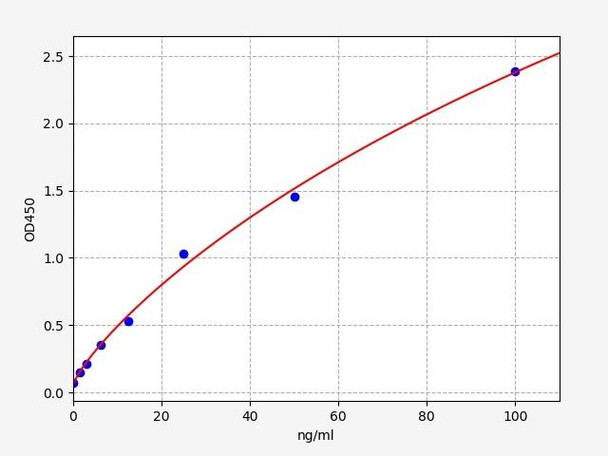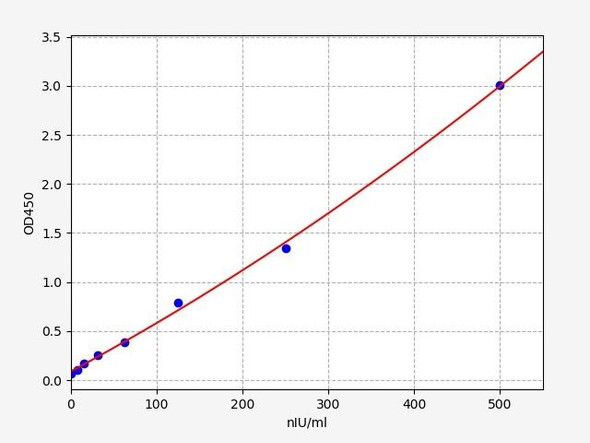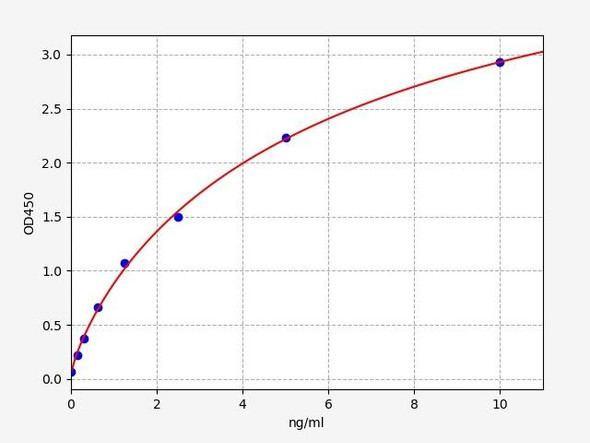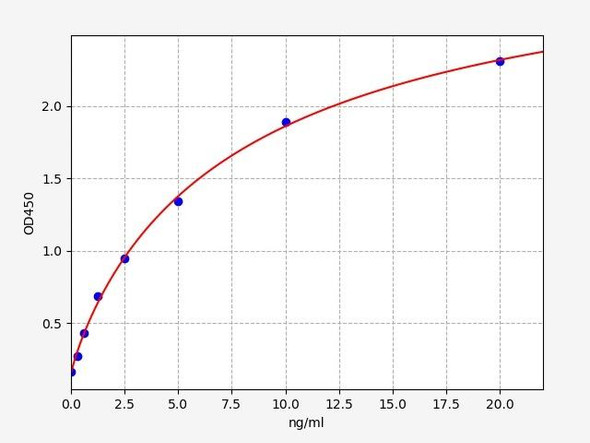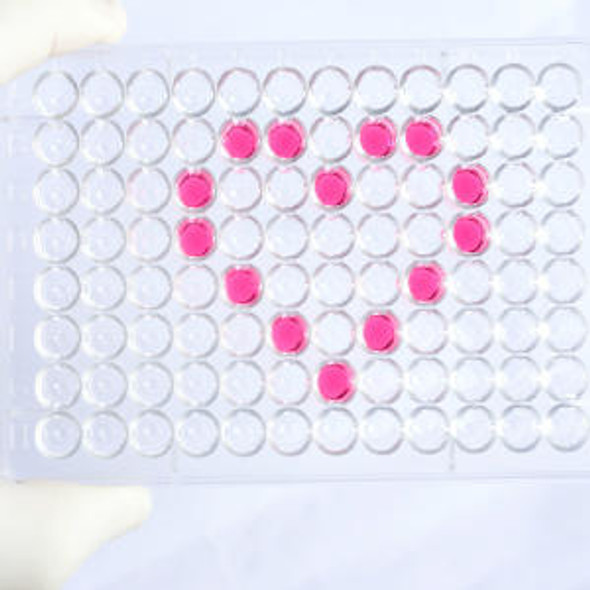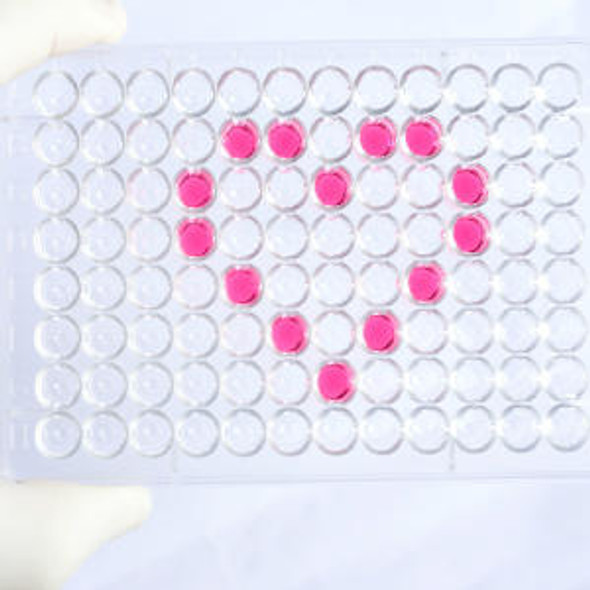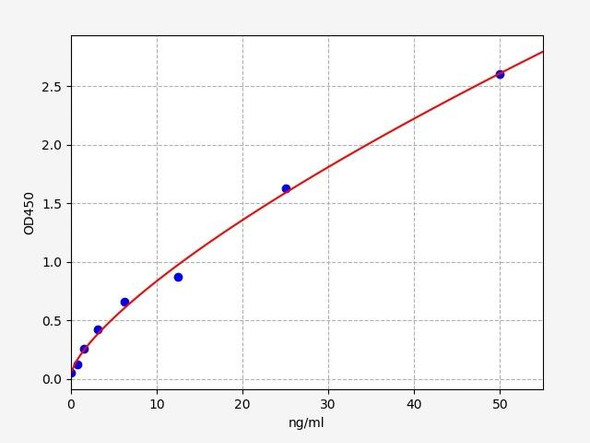Human PAR2 / Protease Activated Receptor 2 ELISA Kit
- SKU:
- HUFI02697
- Product Type:
- ELISA Kit
- Size:
- 96 Assays
- Uniprot:
- P55085
- Sensitivity:
- 0.938ng/ml
- Range:
- 1.563-100ng/ml
- ELISA Type:
- Sandwich ELISA, Double Antibody
- Synonyms:
- CFIIRL1, F2RL1, GPCR11, CFIIRL1, coagulation factor II, thrombin receptor-like 1, Coagulation factor II receptor-like 1, F2RL1, GPCR11, GPR11protease-activated receptor 2, G-protein coupled receptor 11, PAR-2, PAR2G protein-coupled receptor-11, prote
- Reactivity:
- Human
Description
| Product Name: | Human PAR2 / Protease Activated Receptor 2 ELISA Kit |
| Product Code: | HUFI02697 |
| Size: | 96 Assays |
| Alias: | CFIIRL1, F2RL1, GPCR11, CFIIRL1, coagulation factor II, thrombin receptor-like 1, Coagulation factor II receptor-like 1, F2RL1, GPCR11, GPR11protease-activated receptor 2, G-protein coupled receptor 11, PAR-2, PAR2G protein-coupled receptor-11, proteinase-activated receptor 2, proteinase-activated receptor-2, Thrombin receptor-like 1 |
| Detection method: | Sandwich ELISA, Double Antibody |
| Application: | This immunoassay kit allows for the in vitro quantitative determination of Human PAR2 concentrations in serum plasma and other biological fluids. |
| Sensitivity: | 0.938ng/ml |
| Range: | 1.563-100ng/ml |
| Storage: | 4°C for 6 months |
| Note: | For Research Use Only |
| Recovery: | Matrices listed below were spiked with certain level of Human PAR2 and the recovery rates were calculated by comparing the measured value to the expected amount of Human PAR2 in samples. | ||||||||||||||||
| |||||||||||||||||
| Linearity: | The linearity of the kit was assayed by testing samples spiked with appropriate concentration of Human PAR2 and their serial dilutions. The results were demonstrated by the percentage of calculated concentration to the expected. | ||||||||||||||||
| |||||||||||||||||
| CV(%): | Intra-Assay: CV<8% Inter-Assay: CV<10% |
| Component | Quantity | Storage |
| ELISA Microplate (Dismountable) | 8×12 strips | 4°C for 6 months |
| Lyophilized Standard | 2 | 4°C/-20°C |
| Sample/Standard Dilution Buffer | 20ml | 4°C |
| Biotin-labeled Antibody(Concentrated) | 120ul | 4°C (Protect from light) |
| Antibody Dilution Buffer | 10ml | 4°C |
| HRP-Streptavidin Conjugate(SABC) | 120ul | 4°C (Protect from light) |
| SABC Dilution Buffer | 10ml | 4°C |
| TMB Substrate | 10ml | 4°C (Protect from light) |
| Stop Solution | 10ml | 4°C |
| Wash Buffer(25X) | 30ml | 4°C |
| Plate Sealer | 5 | - |
Other materials and equipment required:
- Microplate reader with 450 nm wavelength filter
- Multichannel Pipette, Pipette, microcentrifuge tubes and disposable pipette tips
- Incubator
- Deionized or distilled water
- Absorbent paper
- Buffer resevoir
| Uniprot | P55085 |
| UniProt Protein Function: | F2RL1: a G-protein coupled receptor for trypsin and trypsin-like enzymes. Acts as a sensor for proteolytic enzymes generated during infection. Modulates pro-inflammatory responses, and innate and adaptive immunity. It is activated by proteolytic cleavage of its extracellular amino terminus. The new amino terminus functions as a tethered ligand and activates the receptor. Activates several signaling molecules including phospholipase C (PLC), mitogen-activated protein kinase (MAPK), IKK/NFkB and Rho. Elevates intracellular calcium. Can also be transactivated by cleaved PAR1. Can signal synergistically with TLR4 and probably TLR2 in inflammatory responses and modulates TLR3 signaling. Has a protective role in establishing the endothelial barrier; the activity involves coagulation factor X. Proposed to have a bronchoprotective role in airway epithelium, but also shown to compromise the airway epithelial barrier by interrupting E-cadherin adhesion. Involved in the regulation of vascular tone; activation results in hypotension presumably mediated by vasodilation. Associates with a subset of G proteins alpha subunits such as G alpha-q, G alpha-11, G alpha-14, G alpha- 12 and G alpha-13, but probably not with G(o) alpha, G(i) subunit alpha-1 and G(i) subunit alpha-2. However, may signal through G(i) subunit alpha. Believed to be a class B receptor that internalizes as a complex with arrestin and traffic with it to endosomal vesicles, presumably as desensitized receptor, for extended periods of time. Mediates inhibition of TNF-alpha stimulated JNK phosphorylation via coupling to G alpha-q/11; the function involves dissociation of RIPK1 and TRADD from TNFR1. Involved in cellular migration. Involved in cytoskeletal rearrangement and chemotaxis through beta-arrestin-promoted scaffolds; the function is independent of G alpha-q/11 and involves promotion of cofilin dephosphoryltaion and actin filament severing. Induces redistribution of COPS5 from the plasma membrane to the cytosol and activation of the JNK cascade is mediated by COPS5. Involved in the recruitment of leukocytes to the sites of inflammation and is the major PAR receptor capable of modulating eosinophil function such as proinflammatory cytokine secretion, superoxide production and degranulation. During inflammation promotes dendritic cell maturation, trafficking to the lymph nodes and subsequent T-cell activation. Involved in antimicrobial response of innate immune cells; activation enhances phagocytosis of Gram- positive and killing of Gram-negative bacteria. Acts synergistically with interferon-gamma in enhancing antiviral responses. Implicated in a number of acute and chronic inflammatory diseases such as of the joints, lungs, brain, gastrointestinal tract, periodontium, skin, and vascular systems, and in autoimmune disorders. Widely expressed in tissues with especially high levels in pancreas, liver, kidney, small intestine, and colon. Moderate expression is detected in many organs, but none in brain or skeletal muscle. Belongs to the G-protein coupled receptor 1 family. |
| UniProt Protein Details: | Protein type:Membrane protein, integral; Membrane protein, multi-pass; GPCR, family 1; Receptor, GPCR Chromosomal Location of Human Ortholog: 5q13 Cellular Component: early endosome; Golgi apparatus; integral to plasma membrane; plasma membrane; pseudopodium Molecular Function:G-protein alpha-subunit binding; G-protein beta-subunit binding; G-protein coupled receptor activity; protein binding; receptor activity; receptor binding; thrombin receptor activity Biological Process: blood coagulation; defense response to virus; elevation of cytosolic calcium ion concentration; G-protein coupled receptor protein signaling pathway; inflammatory response; innate immune response; interleukin-1 beta secretion; leukocyte migration; negative regulation of JNK cascade; negative regulation of toll-like receptor 3 signaling pathway; neutrophil activation; positive regulation of actin filament depolymerization; positive regulation of cell migration; positive regulation of chemotaxis; positive regulation of cytokine secretion during immune response; positive regulation of eosinophil degranulation; positive regulation of glomerular filtration; positive regulation of I-kappaB kinase/NF-kappaB cascade; positive regulation of JNK cascade; positive regulation of leukocyte chemotaxis; positive regulation of phagocytosis, engulfment; positive regulation of phosphoinositide 3-kinase cascade; positive regulation of positive chemotaxis; positive regulation of pseudopodium formation; positive regulation of Rho protein signal transduction; positive regulation of superoxide release; positive regulation of toll-like receptor 2 signaling pathway; positive regulation of toll-like receptor 3 signaling pathway; positive regulation of toll-like receptor 4 signaling pathway; positive regulation of transcription from RNA polymerase II promoter; positive regulation of vasodilation; regulation of blood coagulation; regulation of I-kappaB kinase/NF-kappaB cascade; regulation of JNK cascade; T cell activation during immune response |
| NCBI Summary: | Coagulation factor II (thrombin) receptor-like 1 (F2RL1) is a member of the large family of 7-transmembrane-region receptors that couple to guanosine-nucleotide-binding proteins. F2RL1 is also a member of the protease-activated receptor family. It is activated by trypsin, but not by thrombin. It is activated by proteolytic cleavage of its extracellular amino terminus. The new amino terminus functions as a tethered ligand and activates the receptor. The F2RL1 gene contains two exons and is widely expressed in human tissues. The predicted protein sequence is 83% identical to the mouse receptor sequence. [provided by RefSeq, Jul 2008] |
| UniProt Code: | P55085 |
| NCBI GenInfo Identifier: | 34577052 |
| NCBI Gene ID: | 2150 |
| NCBI Accession: | NP_005233.3 |
| UniProt Secondary Accession: | P55085,Q13317, Q13346, Q53XJ8, |
| UniProt Related Accession: | P55085 |
| Molecular Weight: | 50kDa |
| NCBI Full Name: | proteinase-activated receptor 2 |
| NCBI Synonym Full Names: | F2R like trypsin receptor 1 |
| NCBI Official Symbol: | F2RL1Â Â |
| NCBI Official Synonym Symbols: | PAR2; GPR11Â Â |
| NCBI Protein Information: | proteinase-activated receptor 2 |
| UniProt Protein Name: | Proteinase-activated receptor 2 |
| UniProt Synonym Protein Names: | Coagulation factor II receptor-like 1; G-protein coupled receptor 11; Thrombin receptor-like 1 |
| Protein Family: | Transcription factor |
| UniProt Gene Name: | F2RL1Â Â |
| UniProt Entry Name: | PAR2_HUMAN |
*Note: Protocols are specific to each batch/lot. For the correct instructions please follow the protocol included in your kit.
Before adding to wells, equilibrate the SABC working solution and TMB substrate for at least 30 min at 37°C. When diluting samples and reagents, they must be mixed completely and evenly. It is recommended to plot a standard curve for each test.
| Step | Protocol |
| 1. | Set standard, test sample and control (zero) wells on the pre-coated plate respectively, and then, record their positions. It is recommended to measure each standard and sample in duplicate. Wash plate 2 times before adding standard, sample and control (zero) wells! |
| 2. | Aliquot 0.1ml standard solutions into the standard wells. |
| 3. | Add 0.1 ml of Sample / Standard dilution buffer into the control (zero) well. |
| 4. | Add 0.1 ml of properly diluted sample ( Human serum, plasma, tissue homogenates and other biological fluids.) into test sample wells. |
| 5. | Seal the plate with a cover and incubate at 37 °C for 90 min. |
| 6. | Remove the cover and discard the plate content, clap the plate on the absorbent filter papers or other absorbent material. Do NOT let the wells completely dry at any time. Wash plate X2. |
| 7. | Add 0.1 ml of Biotin- detection antibody working solution into the above wells (standard, test sample & zero wells). Add the solution at the bottom of each well without touching the side wall. |
| 8. | Seal the plate with a cover and incubate at 37°C for 60 min. |
| 9. | Remove the cover, and wash plate 3 times with Wash buffer. Let wash buffer rest in wells for 1 min between each wash. |
| 10. | Add 0.1 ml of SABC working solution into each well, cover the plate and incubate at 37°C for 30 min. |
| 11. | Remove the cover and wash plate 5 times with Wash buffer, and each time let the wash buffer stay in the wells for 1-2 min. |
| 12. | Add 90 µl of TMB substrate into each well, cover the plate and incubate at 37°C in dark within 10-20 min. (Note: This incubation time is for reference use only, the optimal time should be determined by end user.) And the shades of blue can be seen in the first 3-4 wells (with most concentrated standard solutions), the other wells show no obvious color. |
| 13. | Add 50 µl of Stop solution into each well and mix thoroughly. The color changes into yellow immediately. |
| 14. | Read the O.D. absorbance at 450 nm in a microplate reader immediately after adding the stop solution. |
When carrying out an ELISA assay it is important to prepare your samples in order to achieve the best possible results. Below we have a list of procedures for the preparation of samples for different sample types.
| Sample Type | Protocol |
| Serum | If using serum separator tubes, allow samples to clot for 30 minutes at room temperature. Centrifuge for 10 minutes at 1,000x g. Collect the serum fraction and assay promptly or aliquot and store the samples at -80°C. Avoid multiple freeze-thaw cycles. If serum separator tubes are not being used, allow samples to clot overnight at 2-8°C. Centrifuge for 10 minutes at 1,000x g. Remove serum and assay promptly or aliquot and store the samples at -80°C. Avoid multiple freeze-thaw cycles. |
| Plasma | Collect plasma using EDTA or heparin as an anticoagulant. Centrifuge samples at 4°C for 15 mins at 1000 × g within 30 mins of collection. Collect the plasma fraction and assay promptly or aliquot and store the samples at -80°C. Avoid multiple freeze-thaw cycles. Note: Over haemolysed samples are not suitable for use with this kit. |
| Urine & Cerebrospinal Fluid | Collect the urine (mid-stream) in a sterile container, centrifuge for 20 mins at 2000-3000 rpm. Remove supernatant and assay immediately. If any precipitation is detected, repeat the centrifugation step. A similar protocol can be used for cerebrospinal fluid. |
| Cell culture supernatant | Collect the cell culture media by pipette, followed by centrifugation at 4°C for 20 mins at 1500 rpm. Collect the clear supernatant and assay immediately. |
| Cell lysates | Solubilize cells in lysis buffer and allow to sit on ice for 30 minutes. Centrifuge tubes at 14,000 x g for 5 minutes to remove insoluble material. Aliquot the supernatant into a new tube and discard the remaining whole cell extract. Quantify total protein concentration using a total protein assay. Assay immediately or aliquot and store at ≤ -20 °C. |
| Tissue homogenates | The preparation of tissue homogenates will vary depending upon tissue type. Rinse tissue with 1X PBS to remove excess blood & homogenize in 20ml of 1X PBS (including protease inhibitors) and store overnight at ≤ -20°C. Two freeze-thaw cycles are required to break the cell membranes. To further disrupt the cell membranes you can sonicate the samples. Centrifuge homogenates for 5 mins at 5000xg. Remove the supernatant and assay immediately or aliquot and store at -20°C or -80°C. |
| Tissue lysates | Rinse tissue with PBS, cut into 1-2 mm pieces, and homogenize with a tissue homogenizer in PBS. Add an equal volume of RIPA buffer containing protease inhibitors and lyse tissues at room temperature for 30 minutes with gentle agitation. Centrifuge to remove debris. Quantify total protein concentration using a total protein assay. Assay immediately or aliquot and store at ≤ -20 °C. |
| Breast Milk | Collect milk samples and centrifuge at 10,000 x g for 60 min at 4°C. Aliquot the supernatant and assay. For long term use, store samples at -80°C. Minimize freeze/thaw cycles. |

